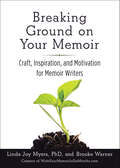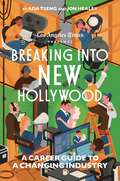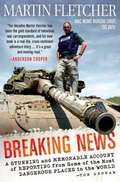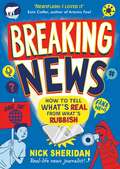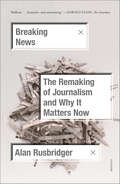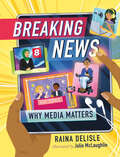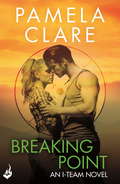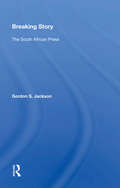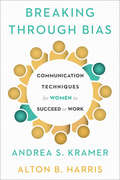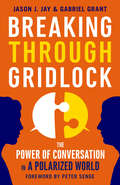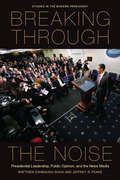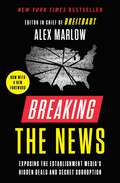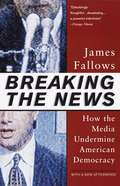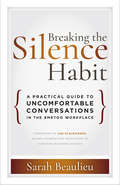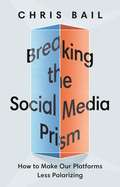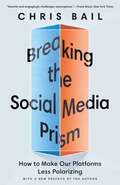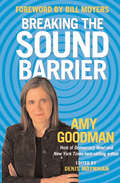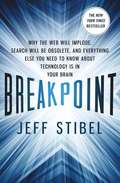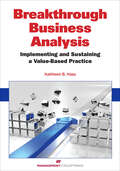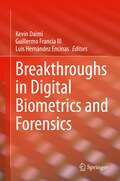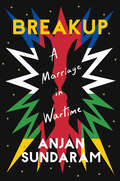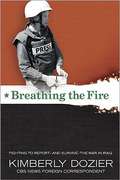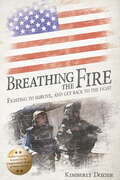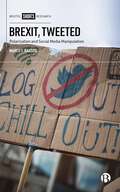- Table View
- List View
Breaking Ground on Your Memoir: Craft, Inspiration, and Motivation for Memoir Writers
by Brooke Warner Linda Joy MyersIn Breaking Ground on Your Memoir, Linda Joy Myers (President of the National Association of Memoir Writers) and Brooke Warner (Publisher of She Writes Press) present from the ground up—from basic to advanced—the craft and skills memoirists can draw upon to write a powerful and moving story, as well as inspiration to write, finish, and polish their own story. Full of rich insights and practical advice and strategies, Breaking Ground on Your Memoir offers all the tools writers need to write a powerful, publishable memoir. In this book you will discover: • how to get focused on what your memoir is about—your themes. • how to build the structure of your story. • techniques to make your memoir come alive. • the secrets of craft: how to write a great scene, colorful and memorable descriptions, narration, and flashback. • how to connect with your reader using through-threads and takeaway so they’ll keep turning the pages, and learn something about their own lives by reading your book. Visit the authors online at WriteYourMemoirInSixMonths.com.
Breaking Into New Hollywood: A Career Guide to a Changing Industry
by The Los Angeles TimesA Simon & Schuster eBook. Simon & Schuster has a great book for every reader.
Breaking News: A Stunning and Memorable Account of Reporting from Some of the Most Dangerous Places in the World
by Martin FletcherMartin Fletcher doesn't claim to be a hero. Yet he didn't flinch, either. During three decades covering wars, revolutions, and natural disasters, Fletcher worked his way from news agency cameraman to top network correspondent, facing down his own fears while facing up to mass killers, warlords, and murderers. With humor and elegance, Fletcher describes his growth from clueless adventurer to grizzled veteran of the world's battlefields. His working philosophy of "Get in, get close, get out, get a drink," put him repeatedly in harm's way, but he never lost sight of why he did it. In a world obsessed with celebrities, leaders, and wealth, Fletcher took a different route: he focused on those left behind, those paying the price. He answers the question: Why should we care? These extraordinary, real-life adventure stories each examine different dilemmas facing a foreign correspondent. Can you eat the food of a warlord, who stole it from the starving? Do you listen politely to a terrorist threatening to blow up your children? Do you ask the tough questions of a Khmer Rouge killer, knowing he is your only ticket out of the Cambodian jungle? And above all, how do you stay sane faced with so much pain?
Breaking News: How to Tell What's Real From What's Rubbish
by Nick SheridanThe perfect gift this Christmas – a funny, practical and ever-so timely guide to the NEWS for 8–12-year-olds. Find out how to understand and navigate 24/7 news, how to spot the facts from the fake . . . and what to do if the news becomes overwhelming. Perfect for fans of Matthew Syed&’s You Are Awesome and Rashmi Sirdeshpande's Dosh. It&’s never been easier to access the news; TV, radio, billboards, newspapers and endlessly buzzing on to the screens in our pockets. But with more and more news available, it&’s hard to know what to trust. Where do stories come from? What&’s real news and what&’s fake? And what role does social media play in all of this? Insightful, hands-on, essential and reassuring, Breaking News will help children navigate the peaks and pitfalls of our modern day news cycle, through laugh-out-loud text, amusing illustration and interactive activities. Praise for Breaking News:'Newsflash: I loved it.&’ – Eoin Colfer, million-copy selling author of ARTEMIS FOWL&‘A perfect read for any budding young journalists out there.&’ – Konnie Huq, TV presenter and author of the COOKIE! series&‘Jam-packed with fascinating facts, this is a fantastically funny and much-needed guide to navigating the news.&’ – Rashmi Sirdeshpande, author of DOSH
Breaking News: The Remaking of Journalism and Why It Matters Now
by Alan RusbridgerAn urgent account of the revolution that has upended the news business, written by one of the most accomplished journalists of our timeTechnology has radically altered the news landscape. Once-powerful newspapers have lost their clout or been purchased by owners with particular agendas. Algorithms select which stories we see. The Internet allows consequential revelations, closely guarded secrets, and dangerous misinformation to spread at the speed of a click.In Breaking News, Alan Rusbridger demonstrates how these decisive shifts have occurred, and what they mean for the future of democracy. In the twenty years he spent editing The Guardian, Rusbridger managed the transformation of the progressive British daily into the most visited serious English-language newspaper site in the world. He oversaw an extraordinary run of world-shaking scoops, including the exposure of phone hacking by London tabloids, the Wikileaks release of U.S.diplomatic cables, and later the revelation of Edward Snowden’s National Security Agency files. At the same time, Rusbridger helped The Guardian become a pioneer in Internet journalism, stressing free access and robust interactions with readers. Here, Rusbridger vividly observes the media’s transformation from close range while also offering a vital assessment of the risks and rewards of practicing journalism in a high-impact, high-stress time.
Breaking News: Why Media Matters (Orca Think #10)
by Raina DelisleKey Selling Points Kids are spending more time on the internet and social media, where they may be exposed to fake news, clickbait, misinformation and disinformation. It's important for them to learn how to become critical news consumers. The media industry is at a critical juncture. After years of being battered by the internet and social media, new business models are starting to emerge. But much damage has been done and trust in the media has dropped to an all-time low. Breaking News is full of tips on how kids can get involved in the media industry and share their thoughts, including writing letters to the editor, taking journalism classes, joining the school paper, getting a paper route and even starting their own media outlet. The book includes stories from journalists, including kids, that will inspire readers to get involved in the industry. The author is an award-winning journalist who worked for daily newspapers, TV news programs and independent online publications across Canada.
Breaking Point: I-Team 5 (I-Team)
by Pamela ClareFans of Suzanne Brockmann, Maya Banks, Christy Reece, Julie Ann Walker and Cindy Gerard will adore Pamela Clare's expertly plotted romantic suspense series, which sets the pages alight with sizzling chemistry. For tension, thrills, romance and passion take a spin with the I-Team.While investigating border violence in Mexico, journalist Natalie Benoit is taken captive. Alone in the hands of ruthless killers, she needs every ounce of courage she possesses to survive. Chief Deputy US Marshal Zach McBride has endured a week of torture and interrogation at the hands of a bloodthirsty drug cartel. Hearing Natalie's cries spurs his survival instincts. With her help, Zach overpowers their captors and they flee. But past loss and tragedy leave each reluctant to follow their hearts, even as the passion between them reaches breaking point. Now they must fight to stay ahead of the danger that hunts them as forces more powerful than they can imagine conspire to destroy them both...Sexy. Thrilling. Unputdownable. Take a wildly romantic ride with Pamela Clare's I-Team: Extreme Exposure, Hard Evidence, Unlawful Contact, Naked Edge, Breaking Point, Striking Distance, Seduction Game.
Breaking Story: The South African Press
by Gordon S. JacksonThis book provides an in-depth analysis of the economic difficulties facing journalism, including the impact of television's increasing share of the advertising market. It focuses on the alternative press, which arose in the mid-1980s at the height of the government's crackdown on dissent.
Breaking Through Bias: Communication Techniques for Women to Succeed at Work
by Alton B. Harris Andrea S. KramerMore than fifty years after the beginning of the Women's Movement and forty years after passage of Title IX, women are still not "making it" in traditionally male careers. Women start their careers on parity with men but generally end them far earlier, having achieved less status, lower compensation, and less satisfaction than men. Breaking Through Bias explains that it is the stereotypes about women, men, work, leadership, and family that hold women back, and it presents an integrated set of communication techniques that women can use to avoid the discriminatory consequences of these stereotypes. Women define career success in a wide variety of ways. But whatever a woman's personal definition, if she is in a traditionally male-dominated career--virtually all high status, highly compensated fields--her career is at risk because of pervasive gender stereotypes. This highly practical book makes clear that women don't need to change who they are to succeed in their chosen careers, and they certainly don't need to act more like men. Women do, however, need to be attuned to the negative gender stereotypes that surround them; they need to anticipate the biases these stereotypes foster, and they need to manage the impressions they make to avoid or overcome these biases. Based on the authors' personal experiences as business leaders and practicing attorneys, involvement in compensation and hiring decisions, extensive mentoring activities, and numerous scientific and academic studies, Breaking Through Bias presents unique, practical, and effective advice about how women can at last break through gender bias in the workplace and win at the career advancement game.
Breaking Through Gridlock: The Power of Conversation in a Polarized World
by Gabriel Grant Jason JayThink about the last time you tried to talk with someone who didn't already agree with you about issues that matter most. How well did it go? These conversations are vital, but too often get stuck. They become contentious or we avoid them because we fear they might. What if, in these difficult conversations, we could stay true to ourselves while enriching relationships and creating powerful pathways forward? What if our divergent values provided healthy fuel for dialogue and innovation instead of gridlock and polarization? Jason Jay and Gabriel Grant invite us into a spirit of serious play, laughing at ourselves while moving from self-reflection to action. Using enlightening exercises and rich examples, Breaking through Gridlock helps us become aware of the role we unwittingly play in getting conversations stuck. It empowers us to share what really matters – with anyone, anywhere – so that together we can create positive change in our families, organizations, communities, and society.
Breaking Through the Noise: Presidential Leadership, Public Opinion, and the News Media
by Matthew Eshbaugh-Soha Jeffrey S. PeakeModern presidents engage in public leadership through national television addresses, routine speechmaking, and by speaking to local audiences. With these strategies, presidents tend to influence the media's agenda. In fact, presidential leadership of the news media provides an important avenue for indirect presidential leadership of the public, the president's ultimate target audience. Although frequently left out of sophisticated treatments of the public presidency, the media are directly incorporated into this book's theoretical approach and analysis. The authors find that when the public expresses real concern about an issue, such as high unemployment, the president tends to be responsive. But when the president gives attention to an issue in which the public does not have a preexisting interest, he can expect, through the news media, to directly influence public opinion. Eshbaugh-Soha and Peake offer key insights on when presidents are likely to have their greatest leadership successes and demonstrate that presidents can indeed "break through the noise" of news coverage to lead the public agenda.
Breaking the News: Exposing the Establishment Media's Hidden Deals and Secret Corruption
by Alex MarlowFrom the editor in chief of Breitbart News, a firsthand account of how the establishment media became weaponized against Donald Trump and his supporters on behalf of the political left. Alex Marlow was just a twenty-one-year-old UC Berkeley student when renowned media mogul Andrew Breitbart hired him as his first employee. Breitbart began mentoring Marlow on how to fight the culture war one headline at a time and to remain resilient in the face of personal attacks. Now, in this eye-opening and timely book, Marlow explains how the establishment press destroyed its own credibility with a relentless stream of &“fake news&” designed to smear Donald Trump and his supporters while advancing a leftist agenda. He also reveals key details on how our information gatekeepers truly operate and why America&’s &“fake news&” moment might never end. Breitbart—and Trump—began banging the drum about &“fake news&” during the 2016 election, and it resonated with millions of voters because they intuitively knew the corporate media was willing to say or write anything to achieve their political ends. It&’s a battle cry that continues to this day. Alex and his team of researchers elucidate the stunning details of the key &“fake news&” moments of the Trump era and take a deep dive into some of the right&’s favorite media targets: from Bloomberg, CNN, The Washington Post, and The New York Times to the tech elite in Silicon Valley. Deeply researched and eye-opening, Breaking the News rips back the curtain on the inner workings of how the establishment media weaponizes information to achieve their political and cultural ends.
Breaking the News: How the Media Undermine American Democracy
by James M. FallowsWhy do Americans mistrust the news media? It may be because show like "The McLaughlin Group" reduce participating journalists to so many shouting heads. Or because, increasingly, the profession treats issues as complex as health-care reform and foreign policy as exercises in political gamesmanship. These are just a few of the arguments that have made Breaking the News so controversial and so widely acclaimed. Drawing on his own experience as a National Book Award-winning journalist--and on the gaffes of colleagues from George Will to Cokie Roberts--Fallows shows why the media have not only lost our respect but alienated us from our public life. "Important and lucid... It moves smartly beyond the usual attacks on sensationalism and bias to the more profound problems in modern American journalism... dead-on."--Newsweek
Breaking the Silence Habit: A Practical Guide to Uncomfortable Conversations in the #MeToo Workplace
by Sarah BeaulieuTop consultant Sarah Beaulieu offers a five-part framework that enables employees to have difficult but necessary conversations about sexual harassment and violence and develop new, better ways of working together. In the wake of the #MeToo movement, employees and leaders are struggling with how to respond to the pervasiveness of sexual harassment. Most approaches simply emphasize knowing and complying with existing laws. But people need more than lists of dos and don'ts—they need to learn how to navigate this uncertain, emotionally charged terrain. Sarah Beaulieu provides a new skills-based approach to addressing sexual harassment prevention and response in the workplace, including using underdeveloped skills like empathy, situational awareness, boundary setting, and intervention.Beaulieu outlines a five-part framework for having conversations about sexual harassment: Know the Facts; Feel Uncomfortable; Get Curious, Not Furious; See the Whole Picture; and Embrace Practical Questions. By embracing these conversations, we can break the cycle of avoidance and silence that makes our lives and workplaces feel volatile and unsafe. Grounded in storytelling, humor, and dozens of real-life scenarios, this book introduces the idea of uncomfortable conversation as the core skill required to enable everyone to bring their full talent and contributions to safe and respectful workplaces.
Breaking the Social Media Prism: How to Make Our Platforms Less Polarizing
by Chris BailA revealing look at how user behavior is powering deep social divisions online—and how we might yet defeat political tribalism on social mediaIn an era of increasing social isolation, platforms like Facebook and Twitter are among the most important tools we have to understand each other. We use social media as a mirror to decipher our place in society but, as Chris Bail explains, it functions more like a prism that distorts our identities, empowers status-seeking extremists, and renders moderates all but invisible. Breaking the Social Media Prism challenges common myths about echo chambers, foreign misinformation campaigns, and radicalizing algorithms, revealing that the solution to political tribalism lies deep inside ourselves.Drawing on innovative online experiments and in-depth interviews with social media users from across the political spectrum, this book explains why stepping outside of our echo chambers can make us more polarized, not less. Bail takes you inside the minds of online extremists through vivid narratives that trace their lives on the platforms and off—detailing how they dominate public discourse at the expense of the moderate majority. Wherever you stand on the spectrum of user behavior and political opinion, he offers fresh solutions to counter political tribalism from the bottom up and the top down. He introduces new apps and bots to help readers avoid misperceptions and engage in better conversations with the other side. Finally, he explores what the virtual public square might look like if we could hit "reset" and redesign social media from scratch through a first-of-its-kind experiment on a new social media platform built for scientific research.Providing data-driven recommendations for strengthening our social media connections, Breaking the Social Media Prism shows how to combat online polarization without deleting our accounts.
Breaking the Sound Barrier
by Amy GoodmanThe host of Democracy Now! breaks through the corporate media&’s lies, sound bites, and silence in this New York Times–bestselling collection of articles. In place of the usual suspects—the &“experts&” who, in Amy Goodman&’s words, &“know so little about so much, explain the world to us, and get it so wrong&”—this accessible, lively collection allows the voices the corporate media exclude and ignore to be heard loud and clear. From community organizers in New Orleans, to the courageous American soldiers who&’ve said &“no&” to Washington&’s wars, to victims of torture and police violence, we are given the extraordinary opportunity to hear ordinary people standing up and speaking out. Written with all of the fierce intelligence and passion for truth that millions have come to expect from Amy Goodman&’s reportage, Breaking the Sound Barrier proves the power that independent journalism can have in the struggle for a better world, one in which ordinary citizens are the true experts of their own lives and communities. Praise for Amy Goodman and Breaking the Sound Barrier &“Amy Goodman has taken investigative journalism to new heights.&” —Noam Chomsky, leading public intellectual and author of Hopes and Prospects &“Amy, as you will discover on every page of this book, knows the critical question for journalists is how close they are to the truth, not how close they are to power.&” —From the foreword by Bill Moyers, author of Moyers on America &“What journalism should be: beholden to the interests of people, not power and profit.&” —Arundhati Roy, author of The End of Imagination &“Those unfamiliar with Goodman&’s work will discover a bold voice that refuses to mince words regardless of the topic or target, along with a wealth of behind-the-headlines reporting.&” —Publishers Weekly
Breakpoint: Why The Web Will Implode, Search Will Be Obsolete, and Everything Else You Need To Know About Technology Is In Your Brain
by Jeff StibelWhat can the human brain and its relationship to the internet tell us about our society, our technologies, and our businesses? A lot, as it turns out. The internet today is a virtual replica of the brain, and the networks that leverage it grow and collapse in ways that are easily predictable if you understand the brain and other biological networks. We're living in the midst of a networking revolution. All of the major technology innovations of the 21st century - social networking, cloud computing, search engines, and crowdsourcing, to name a few - leverage the internet and are thus bound by the rules of networks. We've seen the exponential growth of these technologies, and they've led to a more efficient and tightly connected world. But what many people don't realize is that all networks eventually reach a breakpoint and collapse. This happens in the brain, it happens in nature, it happened to MySpace, and it will happen to Facebook and Google. It is critical to understand where the breakpoint is in the networks you use in order to achieve optimum success. Navigating the world of new technologies today can be like walking through a minefield unless you know the path. Imagine what you could do with a roadmap for where things are headed? In this fascinating look at the future of business and technology, neuroscientist and entrepreneur Jeff Stibel shows how the brain can act as a guide to understanding the future of the internet and the constellation of businesses and technologies that run on it. He'll show how leaders like Marissa Mayer are using artificial intelligence to literally remake Yahoo! and how startups like oDesk and Kickstarter are using crowdsourcing, the next wave of revolutionary technology, to create something much larger and "smarter" than the sum of their parts. Stibel offers a fresh perspective about the future of business and technology in a candid and engaging manner.
Breakthrough Business Analysis: Implementing and Sustaiing and Value-Based Practice
by Kathleen B HassTraditional business analysis jobs are going away and are not coming back. BA tools are growing up, and typical BA tasks are being automated and commoditized. Instead of being regarded as documenters, BAs are being sought out to focus on strategy, innovation, and leadership.Breakthrough Business Analysis: Implementing and Sustaining a Value-Based Practice provides a framework for implementing a BA practice that is strategically positioned and value-based. Realizing the positive impacts of a value-based BA practice could very well mean the difference between success and failure for businesses negotiating 21st century challenges.Value-based business analysis centers on strategy execution, world-class enterprise capabilities, and delivery of innovative products and services. The framework for implementing and sustaining a value-based BA practice involves three phases:1. Readiness: &“Is our organization ready?&”2. Implementation: &“How do we build the BA practice?&”3. Sustainability: &“How do we institutionalize and continue to improve BA practices?&”Take the lead and be your organization's champion of a value-based, breakthrough BA practice that is focused on value to the customer and wealth to the bottom line.
Breakthroughs in Digital Biometrics and Forensics
by Luis Hernández Encinas Kevin Daimi Guillermo FranciaThis book focuses on a wide range of breakthroughs related to digital biometrics and forensics. The authors introduce the concepts, techniques, methods, approaches and trends needed by cybersecurity specialists and educators for keeping current their biometrics and forensics knowledge. Furthermore, the book provides a glimpse of future directions where biometrics and forensics techniques, policies, applications, and theories are headed. Topics include multimodal biometrics, soft biometrics, mobile biometrics, vehicle biometrics, vehicle forensics, integrity verification of digital content, people identification, biometric-based cybercrime investigation, among others. The book is a rich collection of carefully selected and reviewed manuscripts written by diverse digital biometrics and forensics experts in the listed fields and edited by prominent biometrics and forensics researchers and specialists.
Breakup: A Marriage in Wartime
by Anjan SundaramAward-winning journalist Anjan Sundaram, hailed as &“the Indian successor to Kapuscinski&” (Basharat Peer) and praised for &“remarkable&” (Jon Stewart), &“excellent&” (Fareed Zakaria), and &“courageous and heartfelt&” (The Washington Post) work, must reckon with the devastating personal cost of war correspondence when he travels to the Central African Republic to report on preparations for a genocide hidden from the world, leaving his wife and newborn behind in CanadaAfter ten years of reporting from central Africa for The New York Times, Associated Press, and others, Anjan Sundaram finds himself living a quiet life in Shippagan, Canada, with his wife and newborn. But when word arrives of preparations for ethnic cleansing in the Central African Republic, he is suddenly torn between his duty as a husband and father, and his moral responsibility to report on a conflict unseen by the world.Soon he is traveling through the CAR, with a driver who may be a spy, bearing witness to ransacked villages and locals fleeing imminent massacre, fielding offers of mined gold and hearing stories of soldiers who steal schoolbooks for rolling paper. When he refuses to return home, journeying instead into a rebel stronghold, he learns that there is no going back to the life he left behind.Breakup illuminates the personal price that war correspondents pay as they bear witness on the frontlines of humanitarian crimes across the world. This brilliantly introspective, grounded account of one man&’s inner turmoil in the context of a dangerous journey through a warzone is sure to become a modern classic.
Breathing the Fire: Fighting to Report--and Survive--the War in Iraq
by Kimberly DozierCBS News correspondent Kimberly Dozier who battled back from critical injuries sustained in a Baghdad bombing offers a personal memoir of tenacity as well as dedication and drama. Readers learn what wounded military personnel--along with their families and friends--endure on the long road to recovery. Dozier also recounts her rise to network broadcasting, shares insights into the culture of war-zone reporting, and describes the unique demands and perils of women covering dangerous events.
Breathing the Fire: Fighting to Survive, and Get Back to the Fight
by Kimberly Dozier&“A harrowing tale of courage, survival, determination, fellowship and the high price of covering a war . . . a master storyteller and one tough journalist.&” —Tom BrokawCBS Foreign Correspondent Kimberly Dozier shares her compelling story from being injured in Iraq to her recovery . . . shedding light on the ordeal faced by countless combat veterans and civilians. In a flash, Kimberly Dozier&’s life changed. As an award-winning CBS News reporter, Dozier had devoted her career to being in the right place at the right time to capture the story. Suddenly, in the wrong place at the worst time, she became the story, as a deadly explosion tore through her team and the troops they were following, and a word spread worldwide. That Memorial Day in 2006, a routine mission ended with Dozier in a pool of blood on a Baghdad street, a victim of a car bomb that killed her team, cameraman Paul Douglas and soundman James Brolan, as well as U.S. Army Captain James Alex Funkhouser and his translator. Critically injured, Dozier woke to find herself fighting first for survival, then for recovery, and finally to return to the field. Breathing the Fire tracks one woman&’s relentless determination to get the story, to get it right, and to get well again after everything went wrong. The paperback was produced at the request of hospital caregivers, who find the book helps trauma patients and the families supporting them. The author&’s profits go to wounded warrior charities.&“A rare, personal view—with all the attention to detail a great reporter brings to bear—into an experience shared by thousands of wounded Iraq veterans.&” —Dan Rather
Brexit, Tweeted: Polarization and Social Media Manipulation
by Marco BastosDissecting 45 million tweets from the period that followed the Brexit referendum, this book presents an extensive analysis of social media manipulation. The book examines emerging changes in partisan politics, nationalist and populist values, as well as broader societal changes that are feeding into polarization and echo-chamber communication. It pulls the curtain back on the techniques employed to interfere with, and potentially distort, the public discussion. Making complex data accessible to non-technical audiences, this unique post-mortem of the Brexit referendum contributes to our understanding of social media disinformation in the UK and beyond.
Brian Jungen
by Clint Burnham Zoë Gray Brian Jungen Solange De Boer Homi BhabhaPublication initially published in print on the occasion of the exhibition Brian Jungen at Witte de With, 2 Dec 2006 to 11 Feb 2007.
